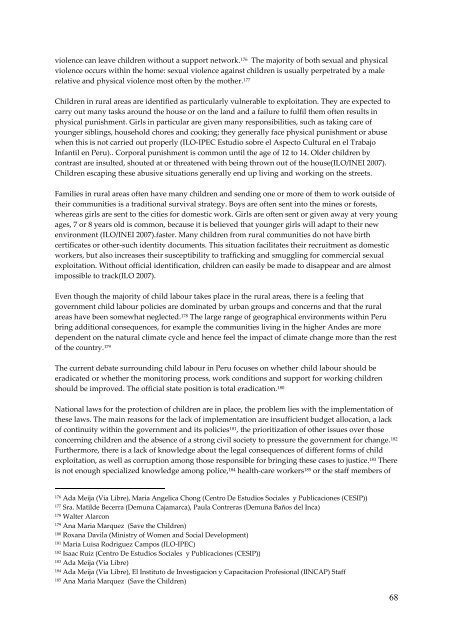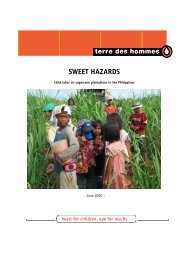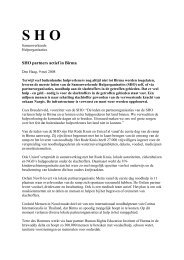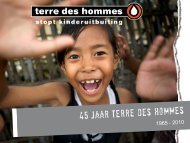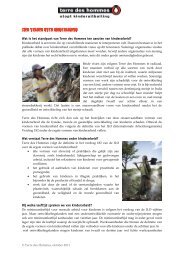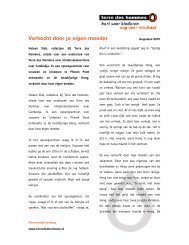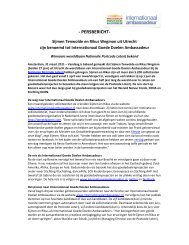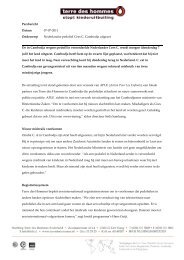Untitled - Terre des Hommes
Untitled - Terre des Hommes
Untitled - Terre des Hommes
- No tags were found...
You also want an ePaper? Increase the reach of your titles
YUMPU automatically turns print PDFs into web optimized ePapers that Google loves.
violence can leave children without a support network. 176 The majority of both sexual and physical<br />
violence occurs within the home: sexual violence against children is usually perpetrated by a male<br />
relative and physical violence most often by the mother. 177<br />
Children in rural areas are identified as particularly vulnerable to exploitation. They are expected to<br />
carry out many tasks around the house or on the land and a failure to fulfil them often results in<br />
physical punishment. Girls in particular are given many responsibilities, such as taking care of<br />
younger siblings, household chores and cooking; they generally face physical punishment or abuse<br />
when this is not carried out properly (ILO-IPEC Estudio sobre el Aspecto Cultural en el Trabajo<br />
Infantil en Peru).. Corporal punishment is common until the age of 12 to 14. Older children by<br />
contrast are insulted, shouted at or threatened with being thrown out of the house(ILO/INEI 2007).<br />
Children escaping these abusive situations generally end up living and working on the streets.<br />
Families in rural areas often have many children and sending one or more of them to work outside of<br />
their communities is a traditional survival strategy. Boys are often sent into the mines or forests,<br />
whereas girls are sent to the cities for domestic work. Girls are often sent or given away at very young<br />
ages, 7 or 8 years old is common, because it is believed that younger girls will adapt to their new<br />
environment (ILO/INEI 2007).faster. Many children from rural communities do not have birth<br />
certificates or other-such identity documents. This situation facilitates their recruitment as domestic<br />
workers, but also increases their susceptibility to trafficking and smuggling for commercial sexual<br />
exploitation. Without official identification, children can easily be made to disappear and are almost<br />
impossible to track(ILO 2007).<br />
Even though the majority of child labour takes place in the rural areas, there is a feeling that<br />
government child labour policies are dominated by urban groups and concerns and that the rural<br />
areas have been somewhat neglected. 178 The large range of geographical environments within Peru<br />
bring additional consequences, for example the communities living in the higher An<strong>des</strong> are more<br />
dependent on the natural climate cycle and hence feel the impact of climate change more than the rest<br />
of the country. 179<br />
The current debate surrounding child labour in Peru focuses on whether child labour should be<br />
eradicated or whether the monitoring process, work conditions and support for working children<br />
should be improved. The official state position is total eradication. 180<br />
National laws for the protection of children are in place, the problem lies with the implementation of<br />
these laws. The main reasons for the lack of implementation are insufficient budget allocation, a lack<br />
of continuity within the government and its policies 181 , the prioritization of other issues over those<br />
concerning children and the absence of a strong civil society to pressure the government for change. 182<br />
Furthermore, there is a lack of knowledge about the legal consequences of different forms of child<br />
exploitation, as well as corruption among those responsible for bringing these cases to justice. 183 There<br />
is not enough specialized knowledge among police, 184 health-care workers 185 or the staff members of<br />
176<br />
Ada Meija (Via Libre), Maria Angelica Chong (Centro De Estudios Sociales y Publicaciones (CESIP))<br />
177<br />
Sra. Matilde Becerra (Demuna Cajamarca), Paula Contreras (Demuna Baños del Inca)<br />
178<br />
Walter Alarcon<br />
179<br />
Ana Maria Marquez (Save the Children)<br />
180<br />
Roxana Davila (Ministry of Women and Social Development)<br />
181<br />
Maria Luisa Rodriguez Campos (ILO-IPEC)<br />
182<br />
Isaac Ruiz (Centro De Estudios Sociales y Publicaciones (CESIP))<br />
183<br />
Ada Meija (Via Libre)<br />
184<br />
Ada Meija (Via Libre), El Instituto de Investigacion y Capacitacion Profesional (IINCAP) Staff<br />
185<br />
Ana Maria Marquez (Save the Children)<br />
68


